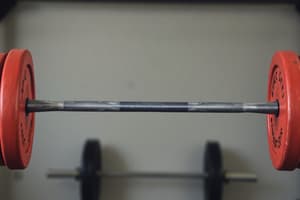Podcast
Questions and Answers
¿Cuáles son los ejercicios que eliminan la posición de split al recibir el peso o eliminan la posición de split y caen bajo la barra en un jerk, y luego presionan el peso con los brazos para completar la extensión?
¿Cuáles son los ejercicios que eliminan la posición de split al recibir el peso o eliminan la posición de split y caen bajo la barra en un jerk, y luego presionan el peso con los brazos para completar la extensión?
Los ejercicios de variación de presión, como Push Jerk y Push Press.
¿Cuál es el propósito de incluir ejercicios derivados en un programa de entrenamiento de fuerza?
¿Cuál es el propósito de incluir ejercicios derivados en un programa de entrenamiento de fuerza?
Para proporcionar un enfoque de entrenamiento más completo y ayudar a los atletas a mejorar sus habilidades en sus respectivos deportes.
¿Cómo se relacionan los ejercicios derivados con los ejercicios tradicionales de halterofilia?
¿Cómo se relacionan los ejercicios derivados con los ejercicios tradicionales de halterofilia?
Los ejercicios derivados se utilizan en conjunción con los ejercicios tradicionales de halterofilia para proporcionar un enfoque de entrenamiento más completo.
¿Cómo se pueden progresar los ejercicios derivados en un programa de entrenamiento de 10 semanas?
¿Cómo se pueden progresar los ejercicios derivados en un programa de entrenamiento de 10 semanas?
¿Cuál es el beneficio principal de incluir ejercicios derivados en un programa de entrenamiento de fuerza?
¿Cuál es el beneficio principal de incluir ejercicios derivados en un programa de entrenamiento de fuerza?
Flashcards are hidden until you start studying
Study Notes
Derivative Exercises
Derivative exercises are variations of weightlifting movements that aim to improve specific aspects of athletic performance. These exercises are often used in sports performance programs, such as Olympic weightlifting, to enhance strength, power, and speed.
Weightlifting Derivatives
Weightlifting derivatives are alternative versions of the Olympic lifts, Snatch and Clean & Jerk. They are designed to focus on specific aspects of these movements and can be grouped into several categories:
- Hang Variations: These exercises eliminate the pull from the floor, with the movement initiated at a predetermined point from mid-shin to upper thigh. Examples include Hang Clean and Hang Snatch.
- Power Variations: These exercises eliminate the full front squat in the catch of the clean or the full overhead squat in the catch of the clean. Examples include Power Clean and Power Snatch.
- Block Variations: These exercises are similar to hang variations but require greater rate of force production due to less initial tension, as there is no need for stabilizing the load. Examples include Block Clean and Block Snatch.
- Pulling Variations: These exercises eliminate the bar turnover & catch phase of the clean or snatch. Examples include Clean Pull, Snatch Pull, Hang High Pull, and Jump Shrug.
- Pressing Variations: These exercises eliminate the split position when receiving the jerk or eliminate the split position and drop under barbell in a jerk, weight is pressed with arms to complete extension. Examples include Push Jerk and Push Press.
- Non-Ballistic Variations: These exercises eliminate leg usage in the push press or eliminate the full overhead squat in the catch of the clean. Examples include Overhead Press and Front Squat.
These variations are designed to target different aspects of athletic performance, such as explosive strength, power production, and rate of force development. By incorporating these exercises into a training program, athletes can improve their performance in their respective sports.
Application of Derivative Exercises
Derivative exercises are not typically programmed in isolation, but rather used in conjunction with traditional weightlifting exercises. They are often included in sports performance programs to provide a more comprehensive training approach.
For example, a ten-week resistance training program might include sets of traditional exercises like Back squat, Military press, and Pull-up, as well as derivative exercises such as Power clean from floor/Clean pull from floor, Stiff-legged deadlift, and Pull-up. The program would progress from strength-endurance to max-strength, with modifications in sets, repetitions, and relative intensity.
Incorporating derivative exercises into a training program can help athletes improve their performance in various aspects of their sport. By focusing on specific aspects of the movement, athletes can develop the necessary strength, power, and speed to excel in their sport.
Studying That Suits You
Use AI to generate personalized quizzes and flashcards to suit your learning preferences.




